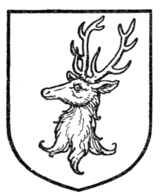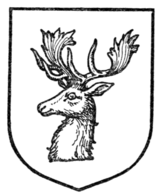When it is necessary owing to a difference of tincture or for other reasons to refer to the horns, a stag or buck is described as "attired" of such and such a colour, whereas bulls, rams, and goats are said to be "armed."
When the stag is said to be attired of ten or any other number of tynes, it means that there are so many points to its horns. Like other cloven-footed animals, the stag can be unguled of a different colour.
The stag's head is very frequently met with, but it will be almost more frequently found as a stag's head caboshed (Fig. 385). In these cases the head is represented affronté and removed close behind the ears, so that no part of the neck is visible. The stag's head caboshed occurs in the arms of Cavendish and Stanley, and also in the arms of Legge, Earl of Dartmouth. Figs. 386 and 387 are examples of other heads.
The attires of a stag are to be found either singly (as in the arms of Boyle) or in the form of a pair attached to the scalp. The crest of Jeune affords an instance of a scalp. The hind or doe (Fig. 388) is sometimes met with, as in the crest of Hatton, whilst a hind's head is the crest of Conran.
The reindeer (Fig. 389) is less usual, but reindeer heads will be found in the arms of Fellows. It, however, appears as a supporter for






